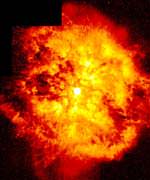
Image credit: Hubble
New research from the Hubble Space Telescope indicates that the majority of large dying Wolf-Rayat stars have a smaller companion star orbiting nearby. This discovery will help astronomers understand how these unique stars evolve in the Universe, and could provide new a new method to estimate their size. Wolf-Rayat stars start out at least 20 times the mass of the Sun, last only a few million years, and then explode as supernovae. It’s now believed that these stars and their companions transfer mass as they orbit one another.
The majority of massive and brilliant but dying “Wolf-Rayet” stars have company – a smaller companion star orbiting nearby, according to new observations using the Hubble Space Telescope. The result will help astronomers understand how the biggest stars in the Universe evolve. It may also resolve the mystery of impossibly massive stars, and calls into question a certain kind of distance estimate that uses the apparent brightness of starlight.
Wolf-Rayet (WR) stars begin life as cosmic titans, with at least 20 times the mass of the Sun. They live fast and die hard, exploding as supernova and blasting vast amounts of heavy elements into space for use in later generations of stars and planets. “I tell people I study the stars that made a lot of the carbon in their bodies and the gold in their jewelry,” says Dr. Debra Wallace of NASA’s Goddard Space Flight Center, Greenbelt, Md. “Understanding how Wolf-Rayet stars evolve is a critical link in the chain of events that ultimately led to life.” Wallace is lead author of papers on this research to be published in the Astronomical Journal and the Astrophysical Journal.
By the time these stars are near the end of their brief lifetimes, during the “Wolf-Rayet” phase, they are fusing heavy elements in their cores in a frantic bid to prevent collapsing under their own immense mass. This generates intense heat and radiation that drives fierce, 2.2 million to 5.4 million mile-per-hour (3.6 million to 9 million km/hr) stellar winds characteristic of WR stars (Image 1). These winds blow off the outer layers of WR stars, greatly reducing their mass and compressing nearby interstellar clouds, triggering their gravitational collapse and igniting a new generation of stars.
Because cosmic distances are so great, what appears as a single star even when viewed through large telescopes (Image 2) may in fact be two or more stars orbiting each other (Images 3 and 4). In the new research, Wallace and her team used the superior resolving power of the Planetary Camera in the Wide-Field Planetary Camera 2 instrument on board Hubble to identify new potential companion stars for 23 of 61 WR stars in our galaxy. Although the apparent companion stars need to be confirmed with a light-analysis technique called spectroscopy, the team was conservative in declaring nearby stars companions.
“The portion of Wolf-Rayet stars having visually identified companion stars zoomed from 15 percent before Hubble to 59 percent with our observations, which included a quarter of the known WR stars in our galaxy,” said Wallace. “I wouldn’t be surprised if future observations reveal companions around an even greater percentage of them.”
The presence of a companion star should significantly influence how these stars evolve, according to the team. One of many possible influences is mass transfer. If the stars come close together at some point in their orbits, their gravitational interaction could cause one to transfer gas to the other, significantly altering their masses over time. Since more massive stars use up their fuel much faster than less massive stars, such a mass transfer could significantly change their lifetimes. Other influences include altering orbits, rotation rates, or mass-loss rates through the pull of their gravity, and the impact of stellar winds. “Astronomers assumed Wolf-Rayet stars were single when trying to calculate how they evolve, but we are finding most have company,” said Wallace. “It’s like thinking married life will be the same as life as a bachelor. A companion star has got to change the life of these stars somehow.”
Since what is seen as one star may in fact be two or even more, stupendous mass estimates of more than a hundred times that of the Sun for certain stars may have to be revised downward. “This actually helps clear up an apparent mystery, because astronomers believe there is a limit to how big a star can be,” said Wallace. “The more massive a star, the faster it consumes its fuel and the brighter it shines. Above about 100 solar masses, a star should essentially blow itself apart through its intense radiation.”
The result also makes a common technique for estimating distances to these stars more uncertain. To get a distance estimate to a star, one gets the spectral type of the star, an analysis of the star’s light that reveals its unique characteristics, like a fingerprint. For a given spectral type, one knows the star’s average absolute luminosity (how bright it would be if it were a certain distance – 32.6 light-years – away). By measuring its apparent luminosity (how bright it appears to be at its actual, but unknown, distance), one can then use the relationship between its apparent and absolute luminosity to determine the actual distance. If there are really two (or more) stars there that you don’t see, the WR star will appear to be brighter than it should for its spectral type and real distance, causing the distance to be misestimated.
The team includes Wallace; Dr. Douglas R. Gies of the Department of Physics and Astronomy, Georgia State University, Atlanta, Ga.; Anthony F. J. Moffat, D?partement de Physique, Universit? de Montr?al, Quebec, Canada; and Michael M. Shara, Department of Astrophysics, American Museum of Natural History, New York, N.Y. The research was funded by NASA.
Original Source: NASA News Release
